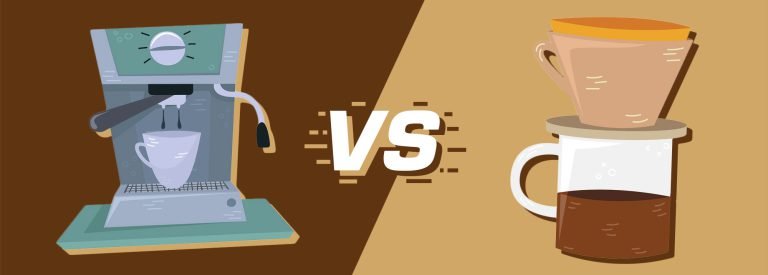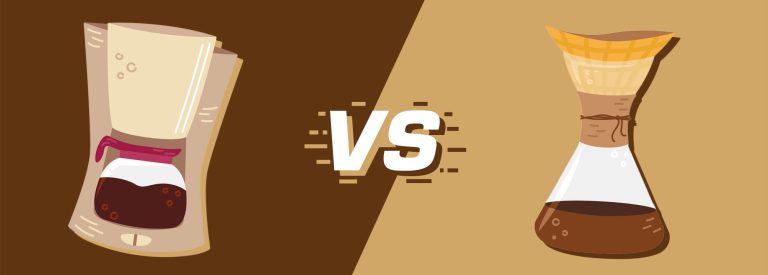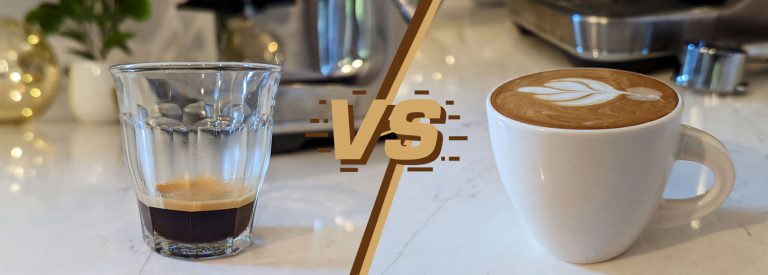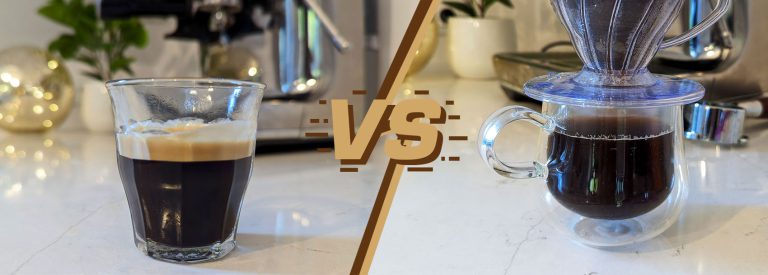Moka Pot vs Pour Over: Barista’s Brew Battle
Moka pot and pour over are two of the most popular methods for manually brewing coffee. One involves heating a three-chambered pot while the other requires hot water to be poured over a bed of ground coffee.
But which one is better?
In this article, I’ll be diving deep into the details of both methods and comparing them side-by-side to determine which comes out on top.
Whether you’re already familiar with these techniques or just looking for a new way to enjoy your morning cup of joe, read on to find out more.
Comparing Moka Pot & Pour Over

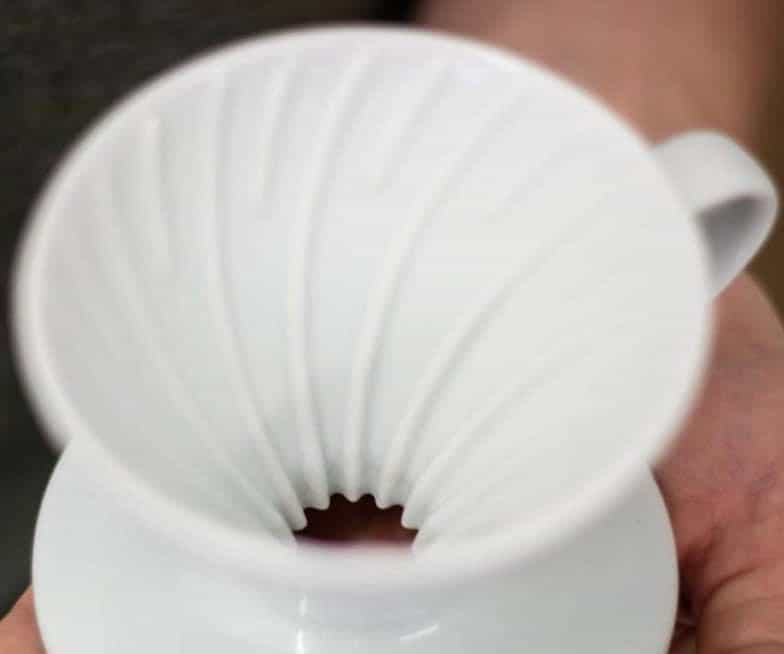
The Moka pot is a stovetop coffee maker that’s quite popular among espresso lovers and for good reason. The brewing process involves filling the bottom water chamber with water and placing ground coffee in the middle basket. Once heated on low-medium heat, steam pressure builds up, pushing the hot water through the coffee grounds and extracting its flavor. The final product is collected in the top chamber where it can be poured into your favorite mug. It’s comparable to an espresso, but not quite the same.
Pour over coffee requires a little bit more patience but promises a rich and flavorful cup of joe. This manual brewing method involves pouring heated water slowly and steadily over the coffee grounds to extract all their flavors gradually. Some of the most well-known pour-over brewers include the Chemex, Hario V60, and Kalita Wave.
Here are the factors to consider when picking between the two brewing methods, followed by a detailed comparison of each feature:
| Features | Moka Pot | Pour Over |
|---|---|---|
| Taste & Flavor | Rich, full-bodied aroma similar to espresso | Clean, complex flavors, customizable |
| Strength | Concentrated and robust | Adjustable strength based on ratio and roast level |
| Ease of Use | Fairly easy to use, minimal pouring technique | Requires learning pouring technique and timing |
| Brewing Speed | 5-10 minutes (grinding to cleanup) | 3-4 minutes (brewing time), quick cleanup |
| Versatility | Limited control over the brewing process, various size options available | High control over temperature, ratio, and grind size, different device options with varying sizes |
| Durability & Portability | Sturdy, made of aluminum or stainless steel, portable, and fits in a bag easily | Material options vary, glass tends to be fragile, compact, portable, but requires a gooseneck kettle |
| Sustainability | Materials are recyclable, fixed metal filter | Requires filters (compostable or reusable options) |
| Cost | $15 to $70 with no recurring costs | $5 to $50 with recurring cost for filters |
Taste, Flavor, & Strength
Let’s begin with the taste and strength of each brewer’s resulting cup.
Moka pot coffee stands out with its rich and full-bodied aroma that tastes similar to espresso. The coffee produced in this pot is concentrated and robust, making it a favorite among those who prefer strong coffee.
On the other hand, pour over coffee is known for its clean, complex flavors and intense aroma. Although resulting in a lighter-bodied cup compared to the Moka pot, you can adjust the strength according to your preference by modifying the coffee-to-water ratio or roast level of the beans used.
Personally, as much as I love the convenience of the Moka pot and its ability to produce strong and great-tasting coffee every time, I must say that there’s something special about pour-over’s complex and customizable flavor profiles that I can’t resist.
Ease of Use
When it comes to brewing coffee, the level of difficulty is a key factor in determining which method is better. For starters, the Moka pot is fairly easy to use. Just fill the bottom chamber with water, add ground coffee to the middle basket, and screw the top chamber in place to get brewing.
That said, there are some factors that need to be taken into account such as using medium-fine grind size beans and setting a low-medium heat on your stovetop for optimal results.
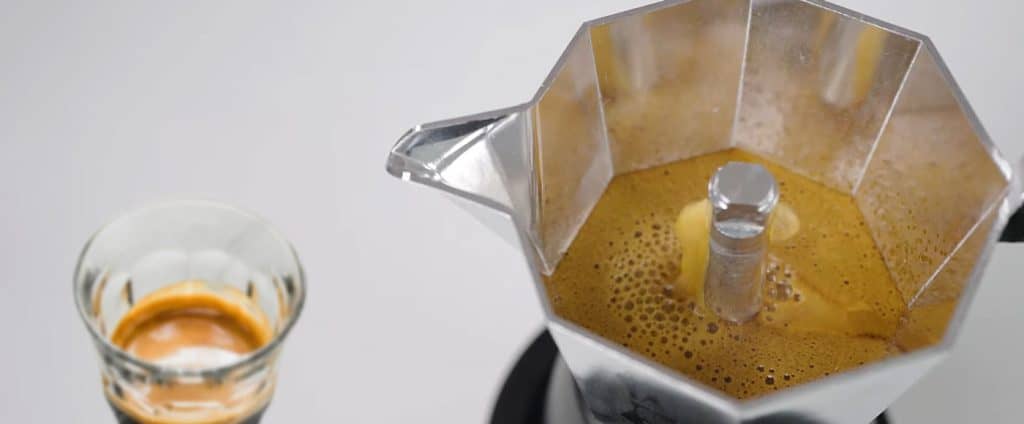
Then there’s pour over. While not difficult per se, learning how to get timing right and mastering the pouring technique requires a small learning curve. You need to bring water up to a temperature between 195°F to 205°F, then using a gooseneck kettle, slowly pour hot water over paper filters filled with medium to medium-fine ground coffee (placed atop the dripper) until all water has passed through.

Overall, both methods are easy enough to use, with their individual requirements being relatively straightforward. However, in terms of ease of use alone, the Moka pot is more beginner-friendly since it doesn’t require any pouring techniques.
Brewing Speed
In terms of how fast you can brew coffee, the Moka Pot takes at least 10 minutes from grinding to brewing and cleaning up. As for the actual brewing time itself, it can take anywhere between 5 to 10 minutes depending on the size of your Moka pot.
Cleaning up can be a bit tricky as well, especially when trying to fully remove all coffee oils and grinds from small crevices in the filter basket and filter.
On the other hand, pour over methods generally take 5 to 7 minutes from preparation to cleanup. When it comes down to just the brewing process though, it only takes about 3 to 4 minutes, and the best part is that cleaning up is super simple – just dispose of the grinds and give it a quick rinse. Here is an article on how to make coffee with a Chemex, and making coffee with a Hario V60 if you’re interested in the details.
So if speed is what you’re looking for, then pour-over has the advantage over the Moka pot. With a quicker prep time and easier cleanup, it could save you some valuable minutes in your morning routine.
Versatility
A coffee brewer’s versatility is important because it allows you to tailor your brew to fit your unique taste. When comparing the Moka pot and pour over, there are some notable differences in terms of versatility.
The Moka pot gives you some degree of control over the brewing process. You can adjust the coffee-to-water ratio and grind size to your liking. However, compared to other methods like pour-over, the level of control with a Moka pot is a bit limited. Also, remember that not all moka pots work on all stovetops, as explained here.
One area where the Moka pot excels in terms of versatility is its range of sizes:
- 0.5-cup (40 ml)
- 1-cup (60 ml)
- 2-cup (90 ml)
- 3-cup (130 ml)
- 4-cup (190 ml)
- 6-cup (340 ml)
- 9-cup (540 ml)
- 12-cup (670 ml)
- 18-cup (810 ml)
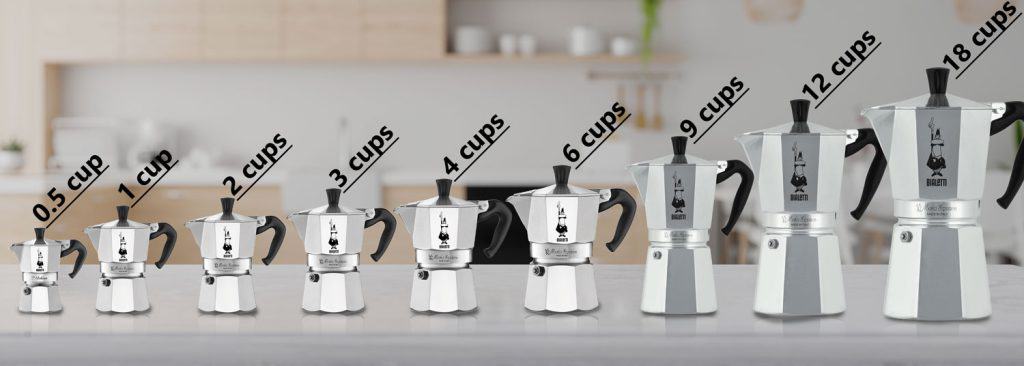
Pour Over brewing methods offer a higher degree of control over the entire brewing process. You can control the water temperature and flow rate, coffee-to-water ratio, and grind size. However, this method requires more hands-on attention as you need to use a timer and manually pour hot water over the coffee grounds.
In terms of sizes, pour over brewers vary depending on your brewing device of choice. For example, a Chemex has four sizes that can produce up to 50 oz of coffee, while the V60 has three sizes that can make up to 6 cups of coffee.
Overall, it’s safe to say that pour over is the more versatile coffee maker while the Moka pot has more flexibility when it comes to choosing the right size for your needs.
Durability and Portability
Let’s have a look at the durability of the materials used for both brewers. The Moka pot is made of either aluminum or stainless steel, which are known for being sturdy and resistant to wear and tear over time.
On the other hand, various options exist when it comes to what material a pour-over brewer uses depending on the device that you’re using. Chemex is made of glass which makes it fragile, while drippers tend to have more durable options than glass and ceramic, such as metal, copper, and plastic. Since drippers are small and compact, they’re also very portable. Their need for a gooseneck kettle, however, is a different issue.
If I had to choose what I take on a trip, I would prefer using my Moka pot when not at home. It fits just right in my bag without me worrying about breakage, and it’s easier to use when on camp since I only need to put it over a source of heat. Getting the temperature right might be tricky at first but I did achieve my ideal cup of coffee. I don’t know how I would use it in a hotel room though…
Sustainability
Sustainability in coffee is important because it ensures that we are not only enjoying our daily brew but also taking care of the environment.
While both methods use less energy compared to electric coffee makers and produce little waste, the Moka pot is a slightly more sustainable way to make coffee than the pour-over. Its materials, steel and aluminum, are recyclable plus it has a fixed metal filter so no single-use filters will contribute to waste in landfills.
Pour over brewers generally require the use of filters, which is a minus if you’re eco-conscious. While they may use compostable paper filters, you may still want to use reusable ones made of metal and cloth.
Additionally, drippers like the V60 also come in plastic models which aren’t ideal if we’re talking about the environment.
Taking into account these factors, I would say that the Moka pot is more eco-friendly brewer than pour over.
Cost
Both the Moka pot and pour over have pretty reasonable price points. The Moka pot can range from $15 up to $70. Once you purchase one, there are no additional costs required since all parts are reusable.
Pour over has a lower initial investment starting from as little as $5 and maxing out at around $50, which is also comparatively lower than some of the more high-end Moka pots. It is worth noting though that it needs separate filters, so if you’re going for paper ones, it has a recurring cost of about 2 to 8 cents per filter in 2024.
So if we’re considering affordability and value for money, both brewers are pretty good choices. Pitting the two against each other though, pour over is more affordable upfront, but the Moka pot doesn’t have any recurring costs so it might just save you more money in the long run.
Moka Pot and Pour Over – Weighing the Pros & Cons
Now that we’ve gotten a closer look at the features of each brewing method, here’s a quick overview of the pros and cons of Moka pot and pour over so you can finally decide which one is for you:
| Brewing Method | Pros | Cons |
|---|---|---|
| Moka Pot | – Small and portable – Easy to use – Produces robust coffee similar to espresso – A wide range of sizes and capacity | – Cleaning is a bit tougher – Limited control once the brewing has started – Can easily have a bitter taste |
| Pour over | – Offers great control over the brewing method – Easy to produce consistent coffee – Fairly affordable | – Requires a bit of patience to brew – Glass brewers can be fragile – Needs extra equipment such as a scale and kettle |
You can also read my Moka pot comparisons to other brewers to find out which one is the best for you:
Leaning towards pour over? Read how this coffee maker compares to other brewing methods:
Summary
Wrapping things up, both the Moka pot and pour over have their merits. The Moka pot is a durable and sustainable brewer that yields espresso-like coffee, while pour over methods have versatility, affordability, and speed to their advantage in producing clean and complex brews.
Personally, having control over the brewing process is very important to me, which is why I like pour over better.
But ultimately, it really comes down to each drinker’s subjective preference.
So which one will you choose? Share your thoughts in the comments.



